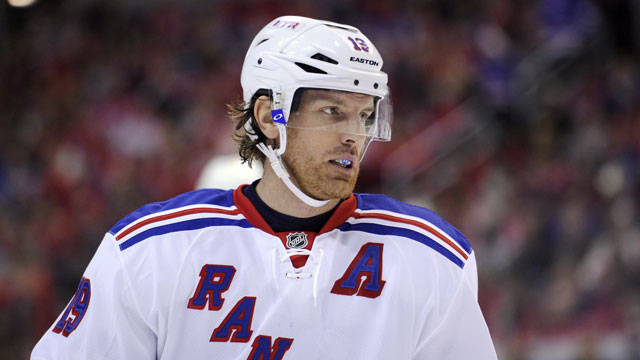The weird thing about the Brad Richards buyout is that it works out well for everyone.
Sure, if left to his druthers, the veteran centre would probably prefer to continue living in Manhattan and playing for the New York Rangers. However, the sting is bound to wear off once he sits down with his financial advisor for a strategic chat.
For New York, there really wasn’t any decision involved. As soon as the cap recapture penalty was baked into the new collective bargaining agreement, general manager Glen Sather was left with no choice but to use one of his compliance buyouts on Richards. Failing to do so would have left the Rangers with dead cap space to deal with in the future.
It would have been irresponsible.
So here we are deconstructing a move that harkens back to the era before the salary cap, when big-money teams like the Rangers had a pronounced advantage in the marketplace. As costly as Richards ended up being for them — he’ll have earned more than $51-million for just three seasons, including the $21.7-million buyout, when all is said and done — there probably isn’t much New York would change about its approach.
Richards was unquestionably the biggest free agent available during the summer of 2011 and was wooed by several teams, including the L.A. Kings. They spent weeks preparing a video highlighting everything they had to offer and even tried to appeal to the player’s love of fine wine and golf.
When he signed with the Rangers instead, it was a coup. They had no choice but to offer the kind of heavily front-loaded, back-diving contract that most top players signed at that time. And even if he never became a big-time difference-maker like they had envisioned, New York appeared in nine lucrative playoff series with him on the roster.
They were also able to pull off a trade for Marty St. Louis this season in part because he is close friends with Richards.
No, this was not nearly as much as a disaster as it might seem if you were to simply focus on the buyout amount and the player’s production (he finished with 56 goals and 151 points in 210 games for the Rangers). In fact, if the NHL didn’t have a salary cap he would undoubtedly be remaining in New York next year.
What this is more than anything is a pound of flesh for league executives who came to loathe contracts like Richards’ because they were designed to circumvent the salary cap. That is why they dreamed up the cap recapture rule, which would have seen the Rangers penalized by more than $16-million over four years if they held on to Richards and he retired in 2016.
Gary Bettman and Bill Daly sternly warned GMs to stop signing back-diving deals under the last CBA. Then they made sure everyone knew they were serious, much to the chagrin of those that didn’t follow orders. The most frustrating part of the cap recapture rule for people like Sather is that the league approved the contracts that are now being affected by it.
“We could have a long debate about that one,” Sather said at the outset of the Stanley Cup Final. “Amazing how rules change sometimes. It’s not something I can comment on. That’s something you’d have to ask Mr. Bettman.
“They decided to do something and we had no influence on it at all.”
At least he had the option of a compliance buyout for Richards to free himself from the burden.
Chicago’s Marian Hossa, Florida’s Roberto Luongo and Detroit’s Henrik Zetterberg and Johan Franzen remain on contracts that take them past their 40th birthday and feature a steep decline in salary over the final few seasons. Boston Bruins captain Zdeno Chara also falls into the same category, although his deal doesn’t fall off as sharply as the others.
If any of those players decides to retire early, their team will be left with dead money on the salary cap. That is part of the legacy of the NHL’s 2012-13 lockout.
The Rangers strongly considered the buyout option for Richards last summer after watching him sit out a couple games as a healthy scratch at the end of the playoffs. However, Sather decided to put it off by a year and Richards recently recalled how important that show of support was to him.
“It made me feel like ‘OK, they’re not giving up’ and that kind of catapulted me into the summer,” he said.
Friday’s news could come with the opposite feeling, but there’s no reason to feel too bad for him.
Richards has already earned more than $89-million during his career, according to capgeek.com, and will likely end up as the highest-earning NHLer ever if he plays another five or six seasons. The fact that a chunk of that money arrived in the form of a buyout is simply the cost of doing business.
Now he’ll be a free agent once again on July 1 — open and available to the highest bidder.


